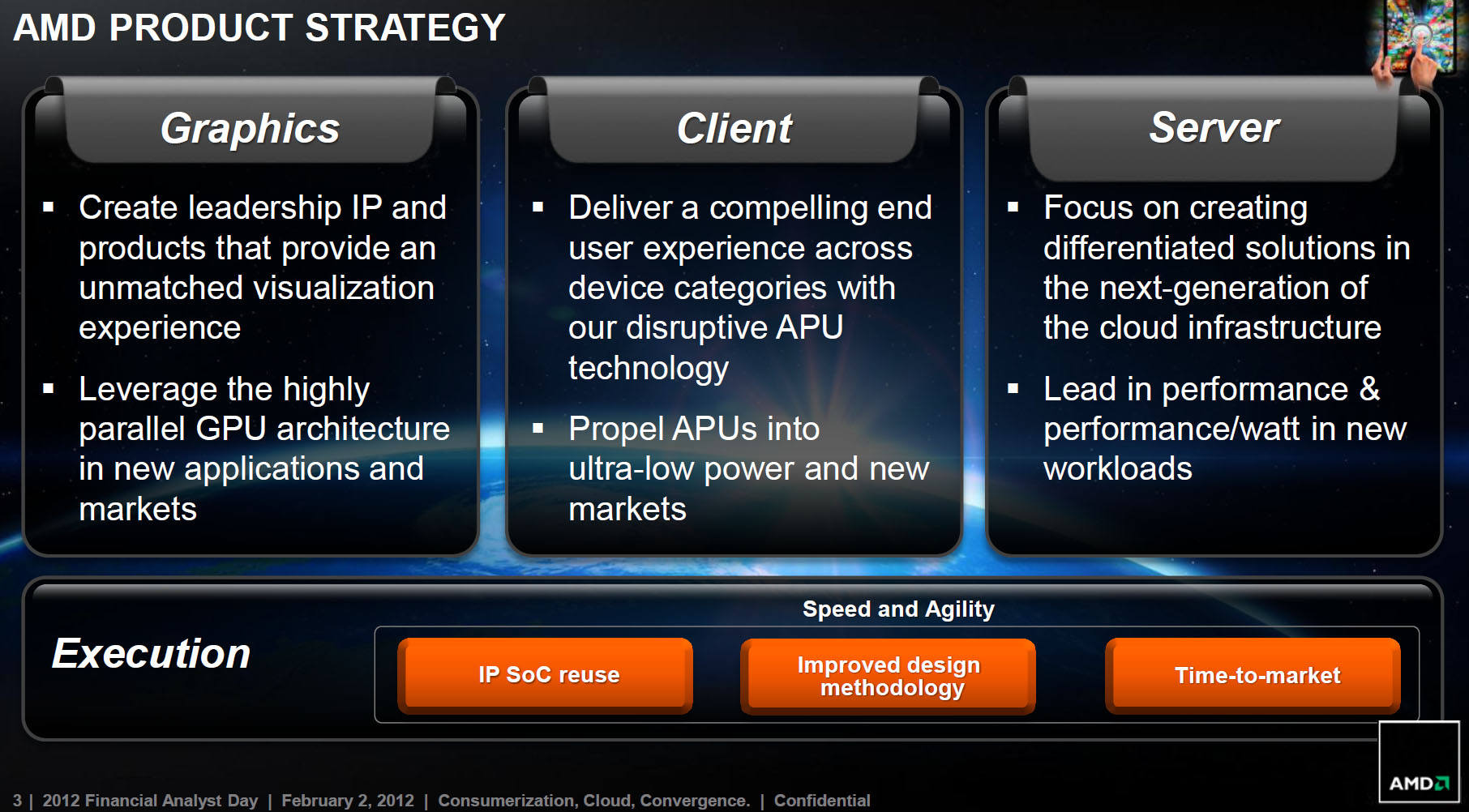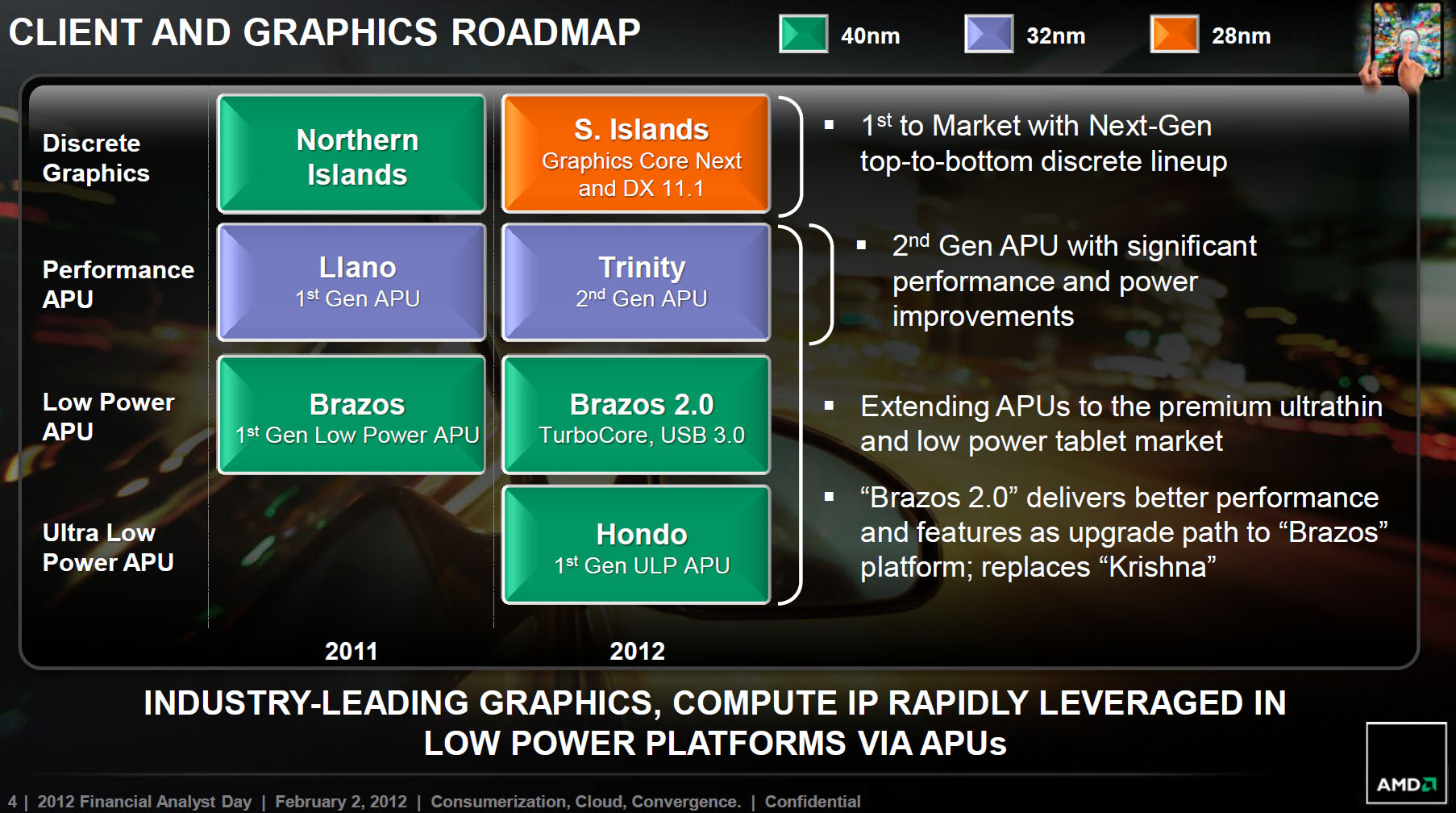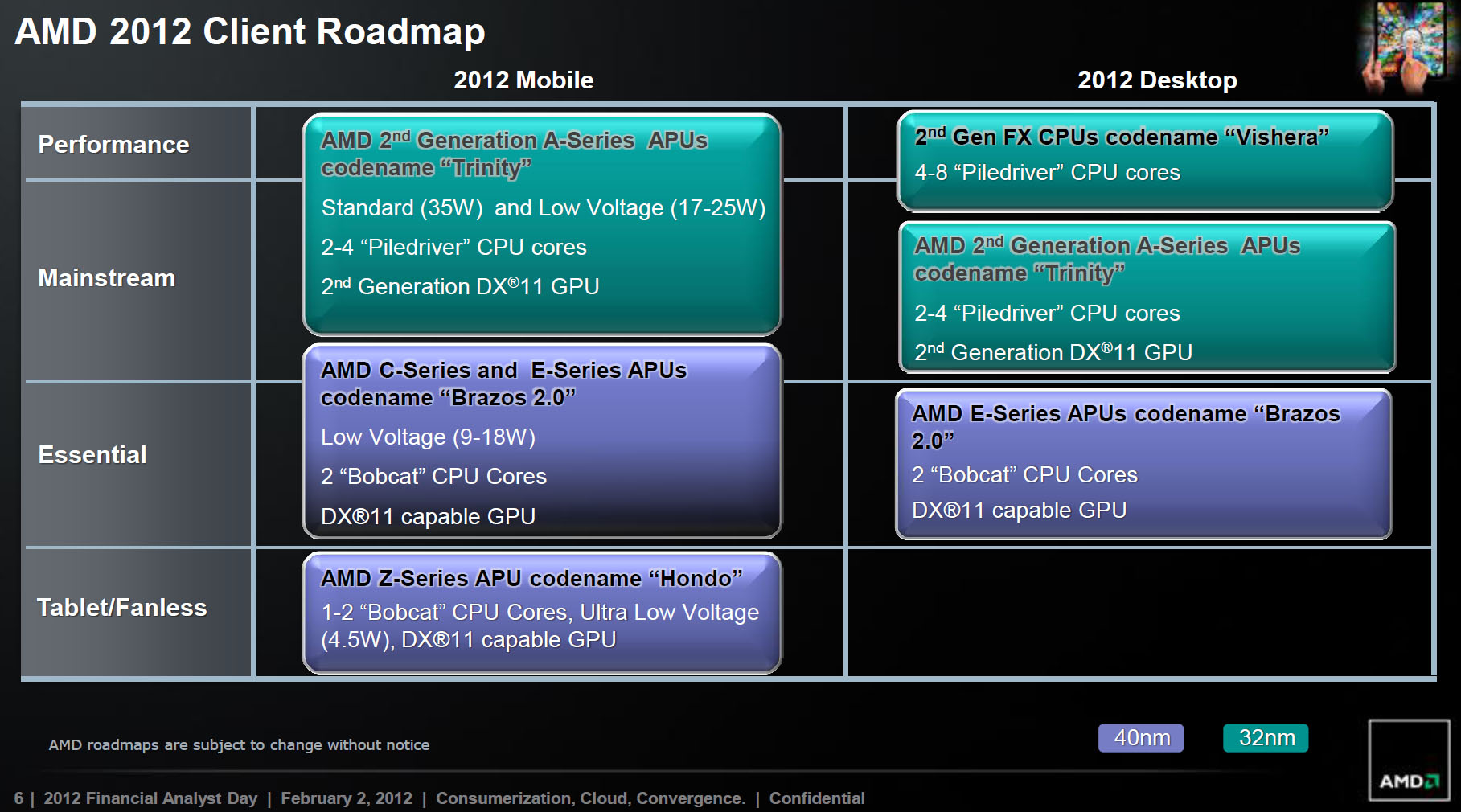Live From AMD's Financial Analyst Day
We've been waiting on AMD's Financial Analyst Day for more information on how the company plans to approach new and current businesses moving forward. Ahead of the big event, AMD pre-briefed us on the news.

AMD Shows Some Of Its Cards
I’m writing this on Wednesday evening with about 15 minutes to go before heading out for a late-night drive from Bakersfield across the flat, dry expanse that is California’s central valley to Sunnyvale, CA. The occasion? AMD’s Financial Analyst Day, which will have begun by the time you read this.
The company’s executive team is planning to cover its corporate strategy, its approach to technology moving forward, existing products, and then deliver financial guidance. Though that’s not all interesting to Tom’s Hardware readers, AMD representatives did pre-brief me on some of the more relevant aspects of the day’s planned discussion.
Playing A Smarter Game
The most salient points from AMD’s pre-brief struck me as, frankly, the most sensible moves to make given the segments where it currently excels, struggles, and sees room for growth. Mainly, continue cranking out successful graphics products, and leverage that technology in new places. Easy—the company is already doing that.
In the client desktop and notebook markets, continue improving the APU concept, and work with ISVs to ensure there’s a tangible benefit to blending x86 cores and graphics-oriented logic on the same piece of silicon. Then, push that idea into smaller thermal footprints to drive growth in new markets (the writing’s on the wall as to where that’s heading).
Third, put an emphasis on performance in the server space. Though seemingly a more general goal, there are a handful of specifics to share on that front, too.
AMD In 2012
Get Tom's Hardware's best news and in-depth reviews, straight to your inbox.
The gears are already in motion for AMD’s plans in 2012. Its Southern Islands-based graphics products started shipping in January, and will continue emerging through the first half of the year based on TSMC’s 28 nm manufacturing node.
Elsewhere in the company’s stack, Trinity-based APUs will replace the Llano parts with which we’re familiar today. Trinity retires the Stars processor architecture in favor of Piledriver. The code-name soup starts to get pretty thick right about here, but bear with me. Piledriver is, of course, the successor to AMD’s maligned Bulldozer architecture.
Our hope with Trinity is that the company’s engineers will have made the right modifications and can deliver processing cores appreciably more effective than what the Llano-based APUs already offer. In some applications, those older Stars-based cores are faster than Bulldozer, so it makes a lot more sense now why AMD never planned to drop two Bulldozer modules into an APU and try to sell those four cores as an improvement over Llano. Piledriver needs to be the design that facilitates this move, and AMD is claiming up to 25% gains over Llano's cores. It should see additional efficiency gains by shifting from the older VLIW5 to Radeon HD 6900's VLIW4 architecture.
The Brazos platform is also expected to evolve into Brazos 2.0, incorporating support for Turbo Core technology (AMDs name for its ability to dynamically increase operating frequency under light workloads) and USB 3.0 connectivity. At the same time, Krishna, originally planned as a 28 nm Brazos replacement, is being shelved.
Under Brazos 2.0, AMD plans to launch its first-gen ultra-low power APU code-named Hondo. The company was already leaking information about this one at last year’s Computex, so its appearance isn’t particularly surprising. We will be curious to see, however, if AMD is successful in driving a two-chip platform based on 40 nm manufacturing into the tablet space it intends to address.
-
We need a speed chart using GPS of your driving speeds on I5 please and fuel efficiency all the way to sunnyvale.Reply
-
wiyosaya 2nd Gen FX in 2012, but when? After the BD fiasco, I am thinking of doing an Intel build, specifically i5-2550k, - something that I have not done in years. I am not so sure that I want to wait for 2nd Gen FX, especially if it remains something less than a value buy.Reply -
ScrewySqrl I'll quote this week's sub-$200 cpu article: "we're almost-shockingly left without an AMD CPU to recommend at any price point." Intel is the only game in town in gaming. APUs won't change thatReply -
peevee New products on 40nm in 2012? While Intel releases theirs on 22 nm? Translating to 4 times cheaper transistors? How AMD is going to compete? And look at the 2013 Client Roadmap - "Steamroller" (supposedly 2nd gen after BD) cores are BELOW "Piledriver" - are they going to decrease IPC again?Reply -
ltdementhial peeveeNew products on 40nm in 2012? While Intel releases theirs on 22 nm? Translating to 4 times cheaper transistors? How AMD is going to compete? And look at the 2013 Client Roadmap - "Steamroller" (supposedly 2nd gen after BD) cores are BELOW "Piledriver" - are they going to decrease IPC again?Reply
You're wrong sir, until this day AMD/Nvidia release the lower end products on a old and cheaper plataform as 40nm. maybe you get it wrong and think the APU's are going to be 40nm manofactured...well no the GPU inside the APU is 40nm the CPU is 32 nm...maybe you want an 28nm gpu (southern islands) in a 22nm cpu (intel i don't know what) but that would be non profit as is a new technologie i doesnt come cheap at all, not just for AMD but for any other company willing to make some bucks (insert Intel, ARM, Nvidia or your favorite company here.) in a few years when the x nm process comes out theres going to be people like you sayin... "New" 22nm producs in 202x while X Company is realasing their X nm process?
Oh and by the way...not every nm process/Die/construction is the same at all every company has their own...i dont the exact difference but let say Intel 32nm (CMOS i think)= AMD 45nm SOI = ARM 120nm. -
salgado18 It all looks good, except for two things I just can't understand:Reply
- why are they thinking of keeping 4 cores in 2013, when they advocate paralelism? Isn't what they built Bulldozer for?
- why on Earth would they not make FX based on Steamroller? It should be ready, why keep FX outdated against competition when all they need is put the damn things on a chip? -
pjmelect So according to AMD the Piledrive CPU is 25% faster than the Bulldozer CPU is that enough to compete against Intel's new forthcoming chips?Reply



